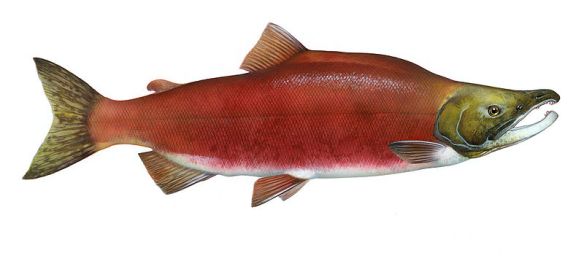Five years ago, it was hypothesized that marine migrants, such as salmon and turtles, travelling long distances to reach their natal waters to spawn (a process known as natal homing) use geomagnetic cues to navigate to the correct area (Lohmann, Putman & Lohmann, 2008). Now, for the first time, there is empirical evidence to support this hypothesis.

Sockeye salmon Oncorhynchus nerka. Credit: Wikipedia
Putman et al. (2013) analysed fisheries data spanning 56 years, from 1953 to 2008, that described the proportion of sockeye salmon Oncorhynchus nerka that took either the northern or the southern route to reach the mouth of the Fraser River, near Vancouver Island, Canada (see the above illustration). They examined whether these proportions were correlated with changes in magnetic field intensity and other environmental factors.
They found that, the more the magnetic field of a strait resembled the one of the Fraser River mouth, the higher the proportion of salmon that used it. It is as if they had previously imprinted on the magnetic field of the river, much like geese imprint on a parent some 13 to 16 hours after hatching, and were able to use this information years later during spawning migration.
The other significant factor affecting their itinerary was Sea Surface Temperature (SST). Years with higher SST were characterized by an increased propotion of salmon choosing the northern route, possibly because fish preferred colder waters.

Changes in magnetic field intensity, SST and the interaction between the two explain up to 66% of the variance in migratory route use.
This study employed a retrospective non-experimental design, which does have its shortcomings, including a multitude of possible confounding variables. Notwithstanding, these findings are crucial to understanding natal homing mechanisms and, as Putman et al. put it, “call for experiments on the navigation abilities of adult salmon as well as further investigation into the magnetic imprinting hypothesis”.
PS: I would like to thank my brother for drawing my attention to this study.
References:
Lohmann, K. J., Putman, N. F., & Lohmann, C. M. F. (2008). Geomagnetic imprinting: A unifying hypothesis for long-distance natal homing. Proceedings of the National Academy of Sciences, 105(49), 19096-19101. doi: 10.1073/pnas.0801859105
Putman, M. F., Lohmann, K. J., Putman, E. M., Quinn, T. P., Klimley, A. P., & Noakes, D. L. G. (2013). Evidence for geomagnetic imprinting as a homing mechanism in Pacific Salmon. Current Biology, 23, 1-5. doi: 10.1016/j.cub.2012.12.041

